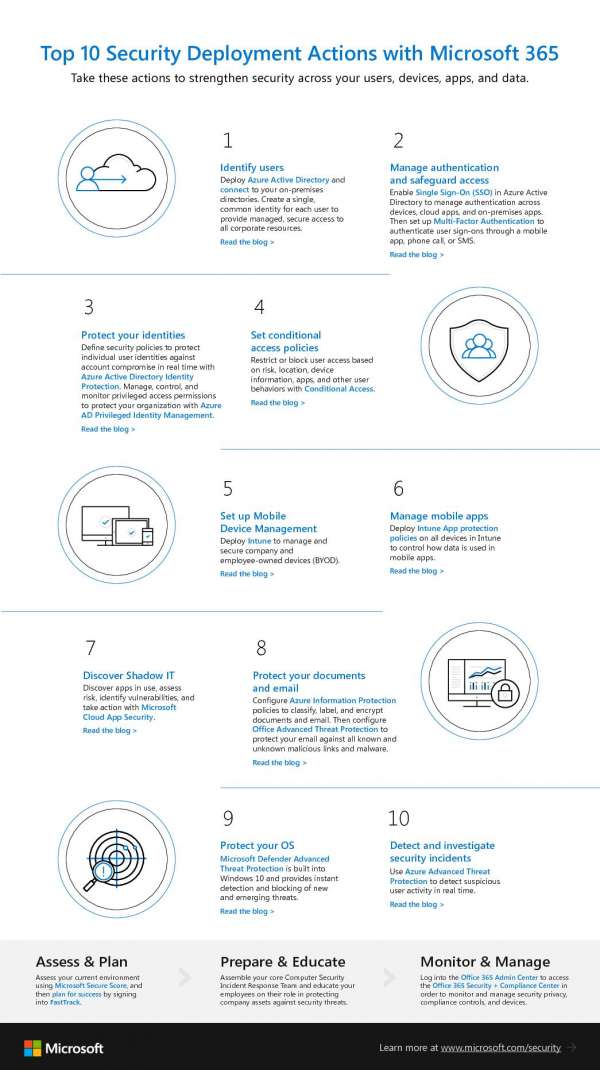Do you or someone you know love to solve problems and help people with their technology? Looking for variety and challenge in your professional career? Good news, Vermont Panurgy is hiring a Network Administrator! Take a look at the job description by clicking below, and send your cover letter and resume to info@panurgyvt.com!
Measuring the value of moving to the cloud — and innovative ways to get there
With the financial services industry facing challenges in data management reliability, governance and security, there is no time to waste on moving to the cloud. Organizations that act decisively in cloud adoption will quickly discover new paths to innovation. In this Microsoft Industry Blog post, Microsoft CTO Laurent Verdier outlines the transformative benefits of moving to the cloud and provides tips for determining and taking the best path. Read the blog for ideas on how cloud adoption can set you up for long-term success.
Twelve Days of Tech Tips for the Holiday Season
When the holiday season rolls around, it’s not just Santa Claus that’s coming to town. Scammers, hackers, bots and all sorts of other nefarious actors will always be around, waiting in the wings to take advantage of eager and ignorant consumers, travelers and revelers. Beware, but do not fear! At the advent of this year’s season of cheer, here are some of Vermont Panurgy’s top tips to keep yourself, your loved ones, your data and your finances safe and sound, enjoying the yuletide with concerns at bay.
Jump To a Tip
- Shop Safe, Shop Smart, Online
- Set up Your New PC for Success
- Getting Rid of Your Old PC
- Travelling with Technology – Dos and Don’ts
- Gift Gadgets with Gusto
- Tech Gifts for Kids: Caution is Key
- Stay Organized and On-Task
- Daily Deals for Days
- Track Your Spending
- Secure Travel Tips
- Think Long-Term Tech
- Keep Tech in its Place
1. Shop Safe, Shop Smart, Online
Whether you are ordering something for a distant relative or finding that rare gem that only exists on that one independent internet store, it’s important to follow some important safety tips when shopping online.
- Make sure the website you are shopping on is secured by looking at the URL (make sure it starts with https://, not just http).
- Avoid making purchases online using public computers or connected to public Wi-Fi. Use only private computers with antivirus and Wi-Fi that is secured with a secret password. If you’re at the library or coffee shop and find something you want to buy, bookmark it and then make the purchase when you get home.
- Make sure your passwords are strong and contain numbers, letters and special characters.
- Use unique passwords for each website and enable multi-factor authentication whenever possible.
- Do not click on suspicious links and beware of spam advertisements on websites that are designed to look like legitimate buttons or links.
2. Set up Your New PC for Success
Got a new PC for the holiday? Here are a few tips to make sure your old PC can be safely recycled, and the new one is all set to go.
- After setting up your new PC for the first time, make sure to check for and run both Windows Updates and any updates available from your PC manufacturer. Who knows how long that gift has been sitting in that box!
- Install and keep up to date antivirus software, preferably with advanced ransomware protection and cloud-based detection response technology.
- Uninstall any software you don’t want/need, and only install software you trust and need to use, downloaded from reputable sources.
3. Getting Rid of Your Old PC
Before you dispose of your old PC, whether donating it to a friend, family member or charity, reselling it or recycling it, make sure all of your personal data is wiped off the hard drive.
There are more options than just throwing your old PC in the trash! There are local companies all over the world that will take old PCs off your hands for free or even pay you if the PC has value, to refurbish and resell. There are also companies and public utilities that take e-Waste and properly recycle them. Don’t add to the landfill more than necessary!
4. Travelling with Technology – Dos and Don’ts
Visiting relatives, taking a long-needed vacation, delivering presents just like Santa; there are a lot of reasons people travel during the holidays. Here are some tech tips for travel so you don’t have to worry while you’re dashing to your connecting flight on Christmas Eve.
- Make sure to power down your laptop, tablet, or other devices before stowing it for travel. Don’t just put it to sleep.
- Keep your original power adapters close and don’t lose them! Beware, many third-party power adapters are not made well and can cause problems with your device’s battery or power supply. And don’t even think of buying a power adapter overseas; voltage differences can cause huge issues with your tech.
- Turn down the brightness on your display. The battery will last longer, and your eyes won’t be as strained; it’s a win-win.
- Avoid exposure to extreme temperatures. If the device does become extremely hot or cold, let it return to normal room temperature before you turn it on.
5. Gift Gadgets with Gusto
There are tons of ads out there during the holiday season aiming to seduce you into buying new technological gadgets. Things like that fancy new smart razor for your husband; a sleeved blanket that pairs with your smartphone and glows in the dark; talking dolls, internet-connected coffee makers; the list goes on. The biggest tip here is to pay attention to the brand. So many cutting-edge gadgets are poorly constructed or sacrifice quality for cheapness, many of them won’t even last until next Christmas. Only buy tech toys like these from brands you trust, and know that as a general rule, you get what you pay for .
6. Tech Gifts for Kids: Caution is Key
So many kids these days are gaga over gadgets, and it can be so fun and rewarding to satisfy their desires, but whatever you do, inform yourself before you buy something! The internet is wide-open, full of potentially damaging behavior and content. Anything that connects to it has the potential to expose your child to things they – and you – may not be ready for. Here are some top tips.
- Learn about the dangers of virtual reality.
- Get to know and use parental controls; make sure inappropriate content is blocked everywhere.
- Teach your kids about online stranger danger. Catfishing is real.
- Configure safe accounts for your children to use, and separate administrative accounts for you.
- Talk to your kids about healthy boundaries and accountability. Depending on their ages, consider setting expectations with a tech contract.
7. Stay Organized and On-Task
There’s so much to keep track of during the holiday season! Decoration inventories, Christmas wish-lists, gift ideas, party invitations, grocery lists, it can quickly make the most organized of us want to throw up our hands and yell “Bah, humbug!”
Keep your lists in order with an organizational tool like OneNote, Evernote, Sticky Notes, even the built-in Notes app on your phone can help a lot! With the ability to organize folders, format text, add images and links, and sync across devices, these tools can be invaluable to the home holiday organizer.
8. Daily Deals for Days
Even with Black Friday and Cyber Monday over and done with, there are still many ways to save money on tech gifts this holiday season. Many electronics retail outlets extend their Cyber Monday deals or run separate holiday promotions that extend into December. Keep an eye on manufacturer websites and sign up for their email notifications for more opportunities. And don’t forget the daily deal websites! During the holiday season, sometimes they will ramp up the offerings to take advantage of the increased traffic.
9. Track Your Spending
The holiday spirit can get us quickly carried away with our purse strings. Keep an eye on your spending with modern financial tools and apps that connect to your bank account or credit card and monitor your purchases. To get your holiday financials under control you can create budgets, create alerts to let you know when you’re close to maxing them out and configure summary reports. At the very least, download your bank or credit card’s smartphone app and keep an eye on it as you go. Help yourself stay in control of your holiday spending.
10. Secure Travel Tips
Beyond keeping your own technology safe, keep yourself and your property safe too by following these critical recommendations. Don’t leave home just to find The Grinch waiting for you when you return!
- Disable instant connection to unsecured Wi-Fi networks.
- Double-check wi-fi network names before joining, and only join networks you trust.
- If unsecured wi-fi is required, never do anything sensitive on it.
- Disable location services while traveling as savvy criminals can use this data to know your home is empty!
- Don’t post pictures or post about holiday travel until you get home. Even with location services off, it doesn’t take much to know you’re not home when you’re telling the world about it!
11. Think Long-Term Tech
The allure of hot tech products can be quite the siren call but resist the urge to drop that cash immediately and consider tech needs down the road. Got a kid graduating in the Spring? Maybe a new laptop for them would be a better idea than another TV for the den. Big travel plans in the summer? Get a jump on it with some new headphones, tablet or e-reading device.
12. Keep Tech in its Place
Probably most importantly, remember that the holiday season is a time of sharing, giving, love and praise. Whatever you do, don’t let your technology take you away from those most precious moments with family and friends. You can use features on your phone like Do Not Disturb and Focus settings to suppress notifications and reduce distractions. You can set schedules and custom wallpapers to remind you to put your phone down. You could even disconnect completely and turn your phone off (don’t worry, you’ll be fine!). Technology has its uses, but when you are in the presence of loved ones, make sure the focus is where it should be.
Happy Holidays from your friends at Vermont Panurgy!
Why Use a Password Manager
With all the password requirements nowadays, complexity requirements, expirations, lockouts, etc., it is nearly impossible for anyone to remember all of their passwords and which one to use on which website without some form of documentation. Many do-it-yourself solutions have arisen, from a notebook you keep in your desk drawer, to a Word document on your Desktop, or even a whiteboard behind your PC. The most secure method though is to use a Password Manager; a third-party app that encrypts and stores all of your passwords for you in one place, keeps it organized and secure. Read on to learn more about the benefits and features of Password Managers.
What is a Password Manager?
A Password Manager is an app that stores your passwords and login info in one central, secure location. Usually encrypted and stored on the cloud, this allows you to access your passwords from multiple devices and sync them seamlessly between them. Many Password Managers also allow you to store other sensitive information, such as bank account numbers, credit cards, addresses, phone numbers, etc. Usually, you have a master password that you can use to access your passwords, but some apps require additional authentication, especially on new devices, such as biometric data (finger print, face scan, etc.) or a secret key. Typically, these apps include a plugin for your browser to auto-fill the stored passwords on websites it recognizes.
Why do I need a Password Manager?
Password Managers can resolve nearly all the potential insecurities surrounding password creation, management and storage. Most Password Managers will let you know if a password you are creating is weak or used on another website. Password Managers can generate secure and random passwords at the drop of a hat. Many will compare your passwords to lists that have been shared on the dark web and let you know if any of them have been compromised.
Password Managers give you the tools to protect your security online. However, a Password Manager isn’t going to change your passwords for you. Spend some time when you first set up your Password Manager to follow its suggestions and update the passwords that have been identified as insecure or compromised, and make sure you store the updated passwords for posterity!
Password Manager Pros and Cons
There are several benefits to a Password Manager and a few potential drawbacks. Here are a few:
- Pro: You don’t have to think up passwords anymore. Password Managers can generate secure passwords for you, automatically enter them into website account creation fields and store the password. Usually, these generated passwords are just a string of random characters, numbers and symbols, making them even more difficult to crack.
- Con: In the unlikely event you lose access to your Password Manager, you won’t be able to get into any of your accounts without resetting your passwords, since you won’t remember any of those complex, auto-generated strings of characters that were created for you.
- Pro: They can save you a lot of time and effort. When visiting a website that requires a login, it’s a lot easier and quicker to just autofill the stored password than it is to find or remember the password, then copy/paste or type it in manually. It saves a ton of headaches!
- Con: When you never have to type in your password, you never are reminded of what it is, and you’ll very likely forget it in short order. As long as you have your Password Manager, this isn’t a problem. But the minute your phone falls off the side of that cruise ship on your Caribbean vacation…
- Pro: Your identity is protected. Since Password Managers make it easy to have a unique password for each login you create, if nefarious actors get into one of your accounts, they won’t be able to use that password to get into anything else.
- BIG Pro: They can help protect you from Phishing Sites and other potential scams. When Password Managers save passwords, they get linked to a specific website URL. Most phishing scams attempt to convince you that you’re visiting a legitimate website although the URL is different. They then con you into entering your username and password, which they then acquire and use to access your legitimate account. Since Password Managers link to URLs, when you visit a phishing site your credentials don’t autofill, thereby giving you an additional clue that the site provided is not legitimate.
- Con: As with anything on the internet these days, Password Managers are only as effective as you make them. No matter how many times your Password Manager tells you your password is not complex enough, or is compromised or stolen, if you don’t do anything about it, the Password Manager can’t help you.
Tips to Effectively Using a Password Manager
Now that you’ve found a Password Manager that you like and have signed up, it’s time to start getting it set up. Here are some tips to get started:
- Make sure you install the plugin for your browser that comes with your Password Manager before you do anything else. If you use multiple browsers, install the plugin on each.
- Start visiting websites and entering passwords. When you see the prompt to save the password in the Password Manager, make sure to hit it.
- If you’ve been saving passwords in your browser already, you can open up that list of passwords from the browser settings to review and make sure you’ve gotten them all into your Password Manager.
- Don’t forget to disable password saving in the browser itself. Otherwise, you may end up hitting the wrong “save password” button and not save them all in the right place.
- Set up all your devices to connect to the Password Manager in the beginning. Print out and store your secret key or whatever added authentication your app needs to set up new devices somewhere secure (i.e, lockbox, safe, safety deposit box, etc.).
- If you’re going to write down your master password, make sure to keep it separately from your devices, and do not label it “master password for Password Manager” or something similar. At least make it hard to recognize its purpose in case someone else finds it.
- Need some help setting up and getting your users going with your chosen password manager app? Contact Vermont Panurgy today to see how we can help!
Why Buy a Business Computer Through a Distributor, Instead of a Retail Store?
Many business owners take for granted the quality of a Personal Computer (PC) purchased for their business. The traditional belief goes as follows: “A PC is a PC. What does it matter where it comes from? Aren’t they all the same?”
The fact of the matter is, though, not all PCs are created equal. In fact, you could have two PCs with exactly the same model number right next to each other, but the performance, quality and reliability of these two PCs could be very different depending on what channels they were purchased through. This article will explore some of the most important differences between these channels, and help you understand why purchasing PCs through commercial distributors is imperative for your business.
Consider The Audience
Think of your average home PC user. Most people don’t do much more than email, social media, web browsing and basic application work on their PCs. Most people consider cost to be a higher factor than quality, especially considering the state of today’s economy. When it comes down to it, your average home user just wants something that works, and doesn’t want to pay an arm and a leg for it.
PC manufacturers have recognized this and developed products marketed to these users to fit within their parameters. This means the overall quality of a consumer PC is lacking, in favor of cheaper parts to bring the overall cost down. This means the operating system installed on these PCs is pared down and simplified. Why would a home user need the features and added cost of a Professional-grade operating system when the cheaper Home version meets all their needs?
This also means that if the PC stops working and needs repair, the user will most likely be okay with sending the PC in for repair and going without for a week or so. They probably have other devices they can use in the meantime, and it’s not a business-critical scenario so the stakes are not as high.
Read between the lines here, and you start to get a picture of the potential pitfalls when buying a PC you intend to use for business, but is marketed towards consumers. These are the PCs you buy in the box stores like Best Buy or Walmart, or purchased directly on the internet, whether via Amazon or another reseller, or even from the manufacturer websites themselves. The easiest way to tell is by looking at which version of Windows is preinstalled. If it has Windows Home edition, it’s going to be a consumer-grade PC.
Quality versus Cost
As mentioned above, consumer-grade PCs typically are built with less reliable components, because they come from cheaper sources that allow the manufacturer to lower their costs. As a result, they are more likely to experience hardware issues and failures in a shorter timeframe.
One client of ours recently purchased an HP laptop from a retail establishment for a new employee. Within a month of purchasing the PC, its hard drive and motherboard started to fail. The warranty covered the cost of repair, but the PC had to be sent in and a week later the PC has yet to be returned. This amount of downtime is much more critical to a business than your average user, and this employee’s productivity has been severely constrained until he gets his PC back.
When you purchase a PC through a business-grade distributor like Vermont Panurgy, you are guaranteed to get higher quality parts, as these PCs are specifically built with business use in mind, and reliability is a much higher priority than affordability. PCs purchased through business channels are less likely to fail, and when they do, business-grade warranties often include onsite repair, or loaner PCs if a mail-in repair is required. Additionally, these warranties can often be extended longer than your average consumer warranty, offering businesses increased longevity to their devices and reducing potentially costly and time-consuming upgrades.
Home versus Pro
The Microsoft Windows operating system comes preinstalled on pretty much all new PCs available today. Unless you’re buying a Mac or a Chromebook, you are almost certainly buying a Windows PC. Many people don’t realize how many different versions of Windows are out there, though. Windows Home, Windows Pro, Windows Enterprise, Windows Education, Windows Pro Education, the list goes on! Windows 11 has a new configuration called “S-mode” that further complicates the topic. It is understandable that people would get overwhelmed by all this and just see the Windows logo and assume all is good.
However, if you purchase a PC with Windows Home and bring it into an office for business use, you will quickly find the limitations to be quite difficult. Windows Home PCs cannot be joined to a Domain, and therefore cannot be added into your network to allow organizational user accounts to log into it, or centralized policies to be applied. Network shares are not accessible, network printers don’t show up, access to the internet itself can even be blocked. It’s a mess!
Windows Home PCs do not allow connections via Remote Desktop either, so there is no way to connect to a Windows Home PC from another machine without third-party software installed. If you ever wanted to connect to your office PC from home over a VPN, you would not want a Windows Home PC in your office.
All these features and more are available in Windows Pro. The good news is upgrading from Home to Pro is not difficult, but it is an added expense and headache that could be avoided by just purchasing a PC specifically set up for Business use.
Availability
Many people tell me they bought a PC at the store because they were in a critical situation and needed something right now. This is an entirely understandable perspective, and though it is unfortunate that unpredictable events can cause this type of need no matter how much advance planning is done, it happens.
While general availability through business channels is usually better than what’s on the shelves at the store, business-grade PCs typically take at least a day or two to ship and deliver. When immediate needs arise, sometimes the local PC store is the only option. This is a very undesirable situation to be in, so we generally recommend a business to have at least one or two extra PCs on hand in case an employee needs one in a pinch. Planning ahead and having spares allows for more flexibility in the moment and makes sure everyone is always using reliable and functional hardware.
Bloatware
Bloatware is a term commonly used in IT circles to identify any software that comes preinstalled on a PC that is unnecessary and potentially taxing on resources. Right now, for example, HP has an agreement with McAfee to pre-install their antivirus product on all consumer PCs they sell. Most businesses already have bought their own antivirus product, so immediately there is the need to remove McAfee in order to install the replacement software, which takes time and effort. If you don’t, you run into more issues after the 30-day McAfee trial expires. Vulnerabilities arise, performance is impacted, and the user ends up getting constant popups to buy a subscription. No fun!
Other software, like unneeded manufacturer apps, games, links to websites, and other consumer-targeted distractions add to the frustration. Business-grade PCs generally have little to none of this bloatware preinstalled, making setup for and use in a work environment much simpler.
Bottom Line
Without a doubt, businesses should always source their IT from commercial channels. That said, if you’ve been in business for any amount of time, you know that curveballs always come. When you find yourself in that no-win situation of a dead PC and no replacement, place great weight on the potential costs of an immediate replacement from the store down the road when considering your options. A day without productivity waiting on an overnight shipment may end up being much less expensive than the potential headaches and issues down the road if you get that consumer PC.
If you are looking for a trusted and timely source for your business’s IT equipment needs, give us here at Vermont Panurgy a call. We always take the requirements of our clients as the most paramount consideration and will work with you to make sure you have all the equipment you need, configured for your business, when you need it. 1 (800) 974-1115. Don’t wait to start the conversation until it’s too late!
Email Encryption: What, Why and How?

Have you ever sent someone a password in an email? Chances are your answer is you have. We all know that sending an email is inherently insecure, but we do it anyway in the interest of expediency and ease. When an email traverses the internet, there is often little to no encryption on it, and any server it passes through may be able to read its contents. If any one of those middlemen has malware on it, then that malware could be analyzing emails for credentials and sending what it finds to bad actors. Once they have your password, only Multi-Factor Authentication and other advanced authentication security systems can save you.
Better to avoid this, right? But then how do you get passwords, credit card numbers, other sensitive, confidential, or otherwise private information from one person to the next? Messaging apps utilizing end-to-end encryption would be one secure method. However, you and the other person must be using the same app and you would also need to know how to find each other on it, which is time-consuming, cumbersome, and not particularly practical.
Another less secure, but generally acceptable method, would be to send one part of the credentials, like the username, with one method, and then the password with another. You could email the username then send the password in a text message. The problem here is that potentially none of the data is encrypted; however, the separation of methods makes matching them up more difficult. This way the hope is that a hacker would only get one and not both transmissions, and your credentials would still be partially protected. This method is not preferrable but is better than emailing alone.
Providing credentials verbally over the phone poses its own problems. You can mishear someone and enter a typo, even if the person spells it out. Also, in providing confidential information verbally there is the risk that someone might overhear you, or, if the person you are calling has you on speaker, then someone else there might be able to overhear you. This method is only reasonably secure when both ends of the line are in private and secure locations.
Considering all this, it’s no wonder so many people just give up and send credentials over email! But fear not, there is hope in the form of email encryption. We here at Vermont Panurgy have tested and utilized a few different email encryption systems, and one of our favorites has turned out to be Microsoft Purview Message Encryption. We already use Exchange Online and Outlook for our email system and since all Microsoft 365 licensing that includes Exchange Online also includes basic email encryption functionality, this option was already included for us, we just needed to enable it.
Enabling message encryption through Microsoft Purview is quite straightforward, and the default template allows for several different encryption options. You can set an email to be encrypted-only, disable forwarding, or mark it confidential so it can only be opened by internal recipients. Once an email has been marked as encrypted, that encryption becomes baked in and all replies, forwards, etc., will stay encrypted as well.
One of the most useful benefits of this particular encryption tool is its integration into Outlook. Any recipient of an encrypted email that is using Outlook, whether via their browser, mobile app or desktop app, and their org has encryption enabled, can receive and open the email right there in Outlook without having to enter any additional authentication. A little lock icon next to the email in the message list, as well as a note at the top of the opened email, indicates the encryption level, but other than that, it reads just like any other email. It even works with external contacts, provided the recipients have also enabled encryption in their Exchange Online system.
For recipients that are not using Outlook with Exchange Online, Microsoft’s encryption system forms what is called a “wrapper” email, which is an email that contains a link to open the encrypted email in a browser. To open the wrapper email, the user either needs to log in with their Microsoft 365 account or send a one-time passcode in a separate message, which they can then use to access the encrypted email. This is very similar in function to most other email encryption products out there.
Once email encryption is activated in your organization, the template can be customized to include your business logo, introductory text, disclaimer text, even the background color of the wrapper email messages and portal. You can also create rules to automatically encrypt messages that meet certain criteria, such as sender or recipient email address, words in the subject line, etc. You can even create a rule to automatically encrypt emails where either the email or its attachment contains certain data types, such as credit card numbers, passport numbers or social security numbers. Impressive!
With such power and protection through such a seemingly simple little “Encrypt” button in Outlook, any organization that has its email system in Exchange Online should have this functionality enabled and customized to meet their needs. If your organization would like some help with this, contact Vermont Panurgy today!
What Makes a Great MSP?

For most business owners, the prospect of choosing a good Managed IT Services Provider (MSP) to set up and/or manage their IT systems (learn more about what an MSP is here) is just as daunting as trying to figure out all their technology needs by themselves. What are the right questions to ask? How do I tell if they are doing a good job? What services does my business need, and what is irrelevant or overkill? Business owners are usually far too busy running their business to research and understand all the concepts, standards, and lingo that MSPs deal with every day, and conversations can often slip into lost-in-translation territory, as a seemingly simple question results in mind-boggling and frustrating technical answers. Read on to reset your brain and consider how best to choose an MSP, and how best to evaluate your existing MSP and make sure it is doing right by you and your company.
MSPs are intentionally flexible businesses, as they are designed from a service-mindset, wanting to give their clients all the support they need in whatever field they work. Technically, there may be differences in how different engineers like to configure devices or how different reps like to word emails, but functionally, MSPs exist to help you with your IT. So, specific technical requirements aside, the best way to choose or evaluate an MSP is not so much related to what they are doing, but how the work is being done and how you are treated in the process.
Think about the best service provider you have ever worked with. The cleaning company who cleans your business. The utility company who supplies your fuel or electricity. The flight attendant or travel agent for your recent business trip or vacation. What aspects of that experience made it the best to you? Most likely, it had to do with a few critical categories: timeliness, friendliness, effectiveness, and expertise. These are some of the most critical categories to evaluate an MSP in, since we use the same metrics to measure pretty much any service we receive. When you call your MSP for help, how quickly do they respond? How friendly and effective are they when resolving your issue? Do they seem to know what they are talking about? Do they anticipate future issues for you before you encounter them? Think less about the service itself, and more about how the interactions went. If your MSP was unable to resolve an issue, or referred you to another provider for support, chances are any other MSP would have done the same thing. Considering that, how happy were you with the interaction otherwise?
The other side to take into consideration is the type of support you want. Some MSPs will only sell you the “total package” supporting everything so they can charge you as much as possible. Other MSPs can be more flexible. Consider first the IT environment of your business. Do you have users using both Mac and Windows workstations? Do you have a central server and networking devices like switches and wi-fi access points? Do you want your MSP to support your mobile devices, like tablets and smartphones? Do you already have someone on staff that can do basic helpdesk stuff like rebooting computers, installing updates, and resetting passwords, or will you need an MSP to help with everything?
Also consider your non-IT environment. Do you have third shift workers that might require 24/7 support availability? Is that something you want to pay for every month, or just as you need it? Where do your staff work from—office, home, work sites, etc.? How do they connect to the resources they need to work?
Finally, think about the times that you have reached out to other tech companies for support. Think about the aspects of that experience that you think could have been improved and apply those to your search for an MSP. Was it difficult to get to speak to someone on the phone when you needed help? Did you have trouble understanding the person you called for help when you did get through? Did emails go unanswered for extended periods? Make sure you have a direct phone number you can call, preferably to a specific person, so you never have to worry about being neglected by your MSP. Consider finding an MSP that hires all their support staff directly and does not outsource their work. Also, look for an MSP who can explain things in a way that makes sense to you and not just to another tech person. Annoyed by all those marketing emails you started receiving after you called in for help? Make sure your MSP is not sharing your contact info with its partners or adding you to marketing mailing lists without your express permission.
Overall, finding the right MSP can be tricky, and while the most obvious indicator may be the price tag, the proof is, as they say, in the pudding. If you are signing a contract, what is the duration? Are you being asked to sign a long-term contract to even start to work with an MSP company? You are the consumer, make sure you get what your business needs that provides you flexibility. An MSP who knows they will do a good job will not need to get you to sign a long contract to work with them. If you are being asked to sign a long-term contract, make sure there is a clause that allows you to back out of the agreement without penalty, or at the very least make sure there is an evaluation period, so you have a chance to try them on for size before you must stay the entire duration of the contract, even if you are not satisfied. Use these questions to help frame your opinion, and if they do not match up to your expectations, then check out another option. You do not want to get locked into a contract with a company that turns out to be far less than you had expected. Make them earn your business!
Is your business growing and you are at a point where IT needs are surpassing your internal capabilities? Are you reading this article and thinking about how your current MSP is just not hitting the mark? Reach out to us here at Vermont Panurgy to see if we would be a good fit! We are dedicated to our clients’ success, hire locally, and work flexibly across multiple platforms and environments. We are always transparent with our clients with causes of issues and recommendations for solutions. We know that in today’s IT world, providing MSP services really means partnering with each business, and we want you to know who you are partnered with, and that we are committed to the success of your business. Call us at (800) 974-1115 option 2 or email info@panurgyvt.com to start the conversation today!
Windows Updates and Your Business

You’re working on your computer, it’s halfway through the second week of the month, and all of a sudden, your PC starts to slow down and lag. Unsure what is going on, you plod forward, hoping whatever is causing the problem will correct itself eventually. After some minutes go by, a notification pops up in the corner letting you know that updates have been installed and the PC will reboot in the evening. Okay, you think. That explains it, things should be good now that it’s done, right? At the end of the day, you close your laptop lid and assume all will be well tomorrow.
The next morning you open up your PC, having forgotten all about the previous day’s issues and alert. But something doesn’t seem right. Certain websites aren’t loading properly. Some documents seem to have trouble saving. Emails aren’t sending. You click the start menu only to find that pernicious little orange dot on the power button is still there! The computer didn’t reboot like it said it would! You then have to reboot it yourself to get things working, and finishing the updates adds more time and causes much more thumb-twiddling than you’d prefer.
What happened? Well, in this case, when you closed your laptop lid, it either put the computer to sleep or into hibernation, which prevented the scheduled reboot from taking place. As much as Microsoft tries to make updates automatic and not affect your work significantly, there are some fundamental obstacles in the way preventing those updates from occurring. All well and good when it happens to you, but what about when it happens to your employees who are less familiar with their technology? What if it happens to your remote employee who doesn’t know a lick about computers other than what you’ve taught them? Will they know what to do?
When dealing with workstation updates in a business, the benefits of being able to monitor, manage and deploy those updates remotely are many. Foremost, you don’t have to rely on your employees to let you know when they’re having trouble. Daily scans will tell you if a PC is pending a reboot, hasn’t checked for updates in a while or is having some other issue preventing updates from occurring properly.
You can also schedule updates to occur at a certain time on a certain day, overriding the automatic process in the Windows operating system and giving you more control. You can create an SOP where all your users make sure to leave their PCs on and connected to the internet on the third Thursday of the month, for example, and have all the updates run at that time.
Complimentary configuration options, such as changing power settings on a PC so that it doesn’t go to sleep when you close the lid, can improve the efficacy of your update plan as well, and can be applied with scripts through the remote management tool so you don’t even need to tell the user anything. You can make sure your PCs are awake to install the updates when you tell it to, and you can tell the PC to reboot automatically even if someone left themselves logged in.
When dealing with Windows servers, managed updates become even more useful. Not only can you schedule those updates to apply overnight, you can specifically time them so they don’t interfere with backups, antivirus scans, cleanup tasks or other tasks that usually run overnight. The precision with which you can schedule your updates ensures that you can minimize the impact of downtime even if you have third shift staff working overnight.
On top of all this, Microsoft includes manufacturer updates for the major PC manufacturers such as HP and Dell in their update catalog, so not only will your machines get the Windows Updates automatically, they’ll also receive the most important firmware, driver, BIOS and other updates from the manufacturer of their PC. No longer will you need to worry about running HP Support Assistant or Dell SupportAssist on modern PCs every few months, keeping them only for diagnostics and uncommon situations where a needed update hasn’t made it to the Microsoft catalog yet.
As you can see, managed workstation updates can take a lot of the headache and anxiety out of having a team on PCs. It’s just one aspect of remote IT monitoring and management, but a vital one that should not be overlooked, especially if you have a team spread across many locations working remotely. Periodic reviews of the managed configuration can help you find areas of opportunity for education and performance improvement in terms of users that aren’t following SOP or aren’t rebooting their PCs manually when required.
Are you interested in learning more about how managed workstation updates can help your company? Vermont Panurgy provides remote workstation update and review services for businesses of all shapes and sizes, and we would be happy to have a conversation with you to see if it’s a fit for you too. Give us a call at 1-802-658-7788 and press 2 to speak to one of our sales representatives and learn more!
Microsoft Teams Phone: A Case Study in Early Adoption
With relentless reliance on dependable phone systems for day-to-day operations in pretty much every business sector, even considering the potential of upgrading or moving to a different system can cause most business owners distress. The cost, the downtime, the business impact — it’s almost too much. It’s completely understandable then that many businesses, which have significantly upgraded their network infrastructure in recent years, are still running on antiquated phone systems.
The pandemic caused a sea shift on phone systems for those of us who needed them for everyday operations. When everyone was suddenly forced to work remotely, office phone systems routing calls around a building with local hardware became obsolete overnight. Call centers shuttered as no one was there to take the calls to keep the business running.
Luckily, many on-site or “on prem” phone systems included the capability to forward calls to external phone numbers, so most businesses were able to eventually jerry-rig a system to forward calls to cell phones of people who needed to get them. But it is undeniable that the pandemic shutdown permanently changed the typical working landscape. Nearly every business out there is now adjusting to a much more significant portion of remote work, which necessitated calls being taken remotely and not on prem.
Most businesses aren’t getting rid of their offices or storefronts though. There will continue to be a need for desk phones, conference rooms, and presentation halls. Thus, business phone systems need to be flexible enough to accommodate both types of workspaces: remote and on prem.
Enter cloud-based phone systems. When you rely on a server in the cloud to centrally manage your phone system, the ability to connect to remote workers becomes much more straightforward. Partnering with a provider that has proper security concerns, versatile utility, and reliable support makes the process even easier. For businesses with a significant portion of workers working remotely, moving the phone system to the cloud is the most logical move.
Here at Vermont Panurgy, after much consideration, we decided to go with Microsoft’s phone system solution: Microsoft Teams Phone. Relatively new to the VOIP phone system game, Teams Phone comes with the backing of the Microsoft brand and is integrated into a communication platform (Microsoft Teams) that we had already been using since March 2020. Microsoft Teams Phones has a decent and ever-growing marketplace of compatible accessories, as well as integration with smartphones, which for us, relieved a potentially significant cost to change. Microsoft is also able to host a business’ phone numbers directly. With Microsoft Teams Phone, you don’t need to get a phone number from your local provider and forward it to your VOIP system; your phone numbers are all included in the subscription cost for Teams Phone. You can even port existing phone numbers over to Microsoft. One less bill to worry about! And often one significantly cheaper too!
Our experience setting up the Microsoft Teams Phone system was surprisingly smooth. All the configuration of the phone system is done in the Teams Admin Center, with everything necessary under the Voice tab. Microsoft’s documentation is thorough, which provides ample information for typical questions; if needed their support is timely and with the proper level of technical aptitude. We were able to get the whole system set up and tested quite quickly.
We got our team up to speed on how to use the new interface and got everyone connected in the methods according to each user’s preference (i.e., using a desk phone, mobile app, computer headset, etc.). We made plenty of calls to each other to test out the various options and methods of use and everyone got comfortable quickly.
When we flipped the switch and went live with Microsoft Teams Phone, our clients immediately noticed an improvement. With clearer calls, less hold time and more reliability, it was an obvious upgrade. After dealing with a few hiccups, we also noticed a vastly improved user experience. Our Exchange calendars are now integrated in with our Teams availability. Now, if one of us is scheduled as busy, call queues skip over that person and automatically go to the next available agent. Direct extensions are easy to implement, and everyone has a direct phone number as well as an extension from the main line. The auto attendant machine-voice-lady has a reasonable cadence to her voice, and being able to type in changes and updates rather than having to re-record a whole welcome message makes our ability to update our clients on important notices simple and efficient.
One of the greatest benefits of being an early adopter of something you believe in is watching it get better. Since we adopted Microsoft Teams Phone, we have seen Microsoft fix a few annoying bugs, add more features and improve the reliability of their system. Just a few examples of those recent improvements are: dynamic 911 capabilities; the ability to integrate existing SIP phones from certain manufacturers; and additional functionality for Teams desk phones. We expect Microsoft will continue to tweak and improve Teams Phones to keep up with industry changes.
Having experienced changing to Microsoft Teams Phone ourselves, and being the helpful MSP neighbors that we are, Vermont Panurgy is ready to help your company transition away from your antiquated phone system to the flexible, multi-platform, cloud-based phone system that is Microsoft Teams Phone. Give us a call today to discuss how we can help!
Top 10 Security Deployment Actions with Microsoft 365
In this infographic, you will learn about the top 10 security actions that nonprofits can use to safeguard IT operations with Microsoft 365. If you would like to learn more, please reach out to Vermont Panurgy today.





